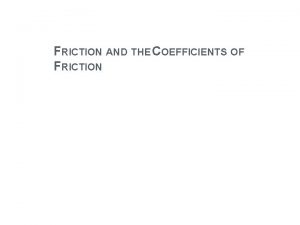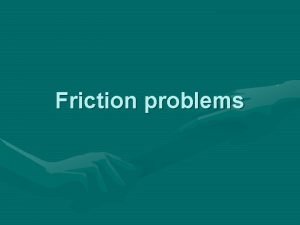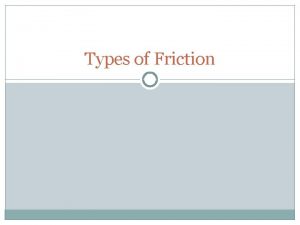Friction Surface Treatment Selection Aggregate Properties Surface Characteristics







- Slides: 7

Friction Surface Treatment Selection: Aggregate Properties, Surface Characteristics, Alternative Treatments, and Safety Effects S. Li Indiana Department of Transportation, and 2 Purdue University

1. OBJECTIVES q To evaluate the long-term performance of the selected friction treatments o HFST with calcined bauxite and steel slag, and o Preservation treatments such as chip seal, micro-surfacing, UBWC, and diamond grinding q To determine the crash-friction correlation to establish crash modification factors (CMFs) q To provide original data on HFST aggregates that can be readily implemented by State DOTs o Standard specifications, and o Evaluation of alternative aggregates

2. AGGREGATE PROPERTIES q Laboratory tests o Mechanical properties: Los Angeles abrasion (LAA), Micro-Deval abrasion, & polished stone value (PSV). o Chemical/physical properties: Al 2 O 3 content, fine aggregate angularity (FAA), and others q Recommendations for aggregate properties Property LAA Loss, % Micro-Deval Abrasion Loss, % Test Method ASTM C 131 ASTM D 6928 PV-10 ASTM D 3319 Al 2 O 3, % by Mass, % Apparent Specific Gravity Water Absorption FAA ASTM C 311 ASTM C 127 AASHTO 304 Aggregate Size Calcined Bauxite Grading D 12. 5 max 6. 3 9. 5 mm 5. 5 max 6. 3 9. 5 mm 35. 0 min 1 3 mm 55. 0 min N. A. 86. 5 min N. A. 3. 30 min N. A. 3. 0 max N. A. 48 Steel Slag 14. 0 max 6. 5 max 26. 0 min 49. 0 min 5. 0 min 3. 50 min 2. 0 max 46

3. SURFACE FRICTION CHARACTERISTICS q Evaluation methods o Laboratory accelerating polishing, and o Actual traffic polishing on test strips q Major factors o Cost: single or double layer application o Appearance/tire wear: aggregate size and gradation q Recommended surface friction characteristics Property Test Method No. 6 Calcined Bauxite No. 8 Steel Slag DFT Friction Coefficient @20 km/h, 90 days ASTM E 1911 0. 90 min 0. 65 min MPD (mm), 90 days ASTM E 2157 or E 965 1. 45 max 1. 35 min

4. PAVEMENT PRESERVATION TREATMENTS q Evaluation methods o Long-term field friction testing on chip seal, micro-surfacing, UBWC, and diamond grinding q Evaluation results o Chip seal can provide satisfactory friction for five years or more. o Microsurfacing can provide durable friction for six years or more. o UBWC can maintain durable and sound friction under high traffic conditions. o Diamond grinding can provide durable friction for both concrete and asphalt pavements.

5. CRASH-FRICTION MODELS q Major distinguishing features o Based on well documented historical crash records and friction test results o Ability to allow for a dynamic evaluation of the CMF due to friction surfacing for life-cycle cost analysis (LCCA). q Prediction models Linear Regression Road Category R Square Interstate 0. 5779 -0. 0456 0. 8057 State Road 0. 4378 -0. 0813 0. 7669 US Route 1. 3781 -0. 1507 0. 9133 Fitted Regression

6. BENEFITS • Provide more realistic estimates on HFST crash reduction. High friction surface treatments are capable of providing crash modification factors of 0. 727 for state roads, 0. 567 for U. S. highways, and 0. 348 for Interstate highways • Provide quantitative friction performance on pavement preservation treatments, including chip seal, microsurfacing, UBWC, and diamond grinding that can be used to address friction concerns at locations with less extreme friction demands. • Provide first-hand data on the mechanistic properties of aggregates for HFST that can be readily implemented by State DOTs. • Provide realistic models that makes it possible to perform life cycle cost analysis (LCCA) for surface treatments
 Chapter 33 aggregate demand and aggregate supply
Chapter 33 aggregate demand and aggregate supply How to calculate aggregate demand
How to calculate aggregate demand Cannot mix aggregate and non aggregate tableau
Cannot mix aggregate and non aggregate tableau Unit 3 aggregate demand aggregate supply and fiscal policy
Unit 3 aggregate demand aggregate supply and fiscal policy Tax multiplier formula
Tax multiplier formula Unit 3 aggregate demand aggregate supply and fiscal policy
Unit 3 aggregate demand aggregate supply and fiscal policy Drawing that shows friction
Drawing that shows friction Are impressions left by friction ridge skin on a surface
Are impressions left by friction ridge skin on a surface













